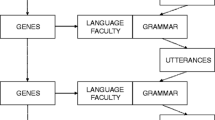Abstract
The effects of learning have been regarded as important factors of the evolutionary process of human linguistic abilities. Our purpose is, by use of computer simulations, to examine the effects of individual and social learning on the evolution of cognitive (e.g., building language hierarchy) and communicative (e.g., intention sharing) abilities of language based on the interplay between biological and cultural evolution of language. In particular, we focus on a co-creative aspect of linguistic communication, which is a synergy of both cognitive and communicative aspects of language. Our simulation results show that roles of individual and social learning can work together and contribute to the evolution of co-creative aspect of linguistic abilities. It is also implied that the stable evolutionary process of cognitive abilities is based on repeated occurrences of the Baldwin effect, and dynamic and less assimilated evolution of communicative traits can work together, contributing to the co-creative communication.





Similar content being viewed by others
References
Smith K (2018) How culture and biology interact to shape language and the language faculty. Top Cogn Sci. https://doi.org/10.1111/tops.12377
Azumagakito T, Suzuki R, Arita T (2018) An integrated model of gene-culture coevolution of language mediated by phenotypic plasticity. Sci Rep 8:8025 (11 pages)
Boyd R, Richerson PJ (1988) Culture and the evolutionary process. University of Chicago Press, Chicago
Weber BH, Depew DJ (eds) (2003) Evolution and learning: the Baldwin effect reconsidered. MIT Press, Cambridge
Suzuki R, Arita T (2013) A simple computational model of the evolution of a communicative trait and its phenotypic plasticity. J Theor Biol 330(7):37–44
Baldwin JM (1896) A new factor in evolution. Am Nat 30(354):441–451
Turney P, Whitley D, Anderson RW (1997) Evolution, learning, and instinct: 100 years of the Baldwin effect. Evol Comput 4(3):55–63
Higashi M, Suzuki R, Arita T (2018) The role of social learning in the evolution on a rugged fitness landscape. Front Phys 6:88
Reboul AC (2015) Why language really is not a communication system: a cognitive view of language evolution. Front Psychol 6:1434
Berwick RC, Friederici AD, Chomsky N, Bolhuis JJ (2013) Evolution, brain, and the nature of language. Trends Cogn Sci 17(2):89–98
Chomsky N (2000) Minimalist inquiries: the framework (mitopl 15). In: Martin R, Michaels D, Uriager-eka J (eds) Step by step: essays on minimalist syntax in honor of Howard Lasnik: 89–155. MIT Press, Cambridge
Harman G (1975) Language, thought, and communication. In: Gunderson K (ed) Minnesota studies in the philosophy of science, vol 7. University of Minnesota Press, Minneapolis, pp 270–298
Higashi M, Suzuki R, Arita T (2018) Communication or cognition? A minimal computational model of evolutionary interactions between individual and social learning. Evolution of language: Proceedings of the 12th International Conference (EVOLANGXII), Torun, Poland, 16–19 Apr 2018, pp 165–167
Bickerton D, Szathmáry E (2011) Confrontational scavenging as a possible source for language and cooperation. BMC Evol Biol 11:261 (7 pages)
Suzuki R, Arita T (2007) Repeated occurrences of the Baldwin effect can guide evolution on rugged fitness landscapes. In: Proceedings of the First IEEE Symposium on Artificial Life (IEEE-Alife’07), Honolulu, HI, USA, 8–14 Apr 2007, pp 8–14
Waddington CH (1953) Genetic assimilation of an acquired character. Evolution 7:118–126
Acknowledgements
This work was supported in part by JSPS/MEXT KAKENHI: JP17H06383 in #4903 (Evolinguistics).
Author information
Authors and Affiliations
Corresponding author
Additional information
Publisher's Note
Springer Nature remains neutral with regard to jurisdictional claims in published maps and institutional affiliations.
This work was presented in part at the 24th International Symposium on Artificial Life and Robotics, Beppu, Oita, January 23–25, 2019.
About this article
Cite this article
Yonenoh, H., Suzuki, R. & Arita, T. Effects of individual and social learning on the evolution of co-creative linguistic communication. Artif Life Robotics 24, 534–541 (2019). https://doi.org/10.1007/s10015-019-00549-7
Received:
Accepted:
Published:
Issue Date:
DOI: https://doi.org/10.1007/s10015-019-00549-7




